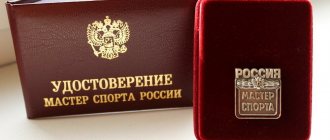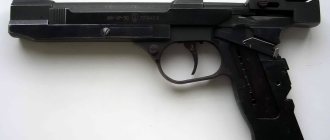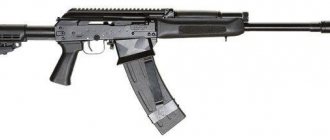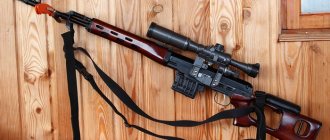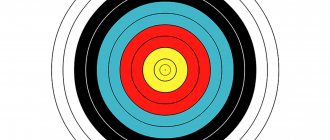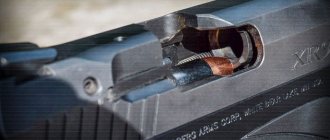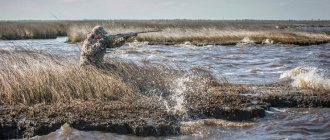Speed in practical shooting. Part 2. The concept of speed, rate of fire.
- Articles
- Training methods
- Speed in practical shooting. Part 2. The concept of speed, rate of fire.
Facebook
Author : Alexander Shooter.
In the article “balancing accuracy and speed” I tried to convey the simple basics and mathematical calculation of accuracy in a PS. In continuation of this topic, I want to tell you my opinion about the general concept of speed in the PS, since this is a very relevant and sensitive issue for many shooters.
For some reason, shooters, looking at the masters, often ask the question - “how to shoot as fast?” This is not quite the correct way to pose the question. I would say - how to shoot as technically... Why? The rate of fire is directly proportional to the shooting technique and experience of the shooter. A high rate of fire does not mean a quick pull on the trigger, as many novice shooters imagine. And I, too, only understood over the years - every shot of the master is aimed and conscious, at any distance and on any target.
An aimed shot does not mean that you need to see a perfectly straight front sight in the rear sight every time. In general, we need to accurately align the front sight with the rear sight at distances of more than 10 meters, while the focus is on the sighting, the target blurs. At distances of 5-7 meters, it is enough to see the front sight through the rear sight, and not necessarily exactly. How far can you deviate from the “straight front sight”? This needs to be found experimentally. Thus, when shooting at a piece of cardboard, you don’t need to line it up perfectly, trying to plant the bullet right in the center of the alpha. The front sight itself can be located at any point in the alpha. At ultra-short distances (3 meters and closer), aiming is carried out along the barrel with mandatory control of the front sight - this is super-aggressive shooting, and we only need to catch the front sight in alpha. Many masters already intuitively hit close targets, sometimes without controlling the front sight, but I consider this a bad habit. Indeed, if the grip is correct, then a highly skilled shooter will have a quality hit even without sight control at close ranges. But the whole problem is in difficult positions and shooting on the move, when the front sight “floats” and the second shot most often goes into the Charlie, and sometimes misses the target, because the shooter sees the target point-blank and tries to pull the trigger as quickly as possible.
How long does it take to aim? Ideally, just enough to see an even front sight in the alpha (in the iron) and make a decision to shoot. It's a fraction of a second. I saw the target, raised the pistol, at the same time chose a free move (!), saw the front sight in the alpha, pulled the trigger (I actually pulled it, not pulled it). All. With a single shot from the chest, all manipulations should take no more than a second.
Now let's talk about such a mythical element as a double shot. You can call it whatever you like - “flash”, “pair”, “double tap”, “hammer”, “reverse hammer”, etc. You can find all these formulations in different training materials. One way or another, these are two consecutive shots, only in some cases the training materials say - the first is aimed, the second is in pursuit, or the first is offhand, the second is aimed. Or both aimed, measuredly. I'll disappoint you, everything is wrong :).
A high-class shooter fires 2 aimed shots, ALWAYS. Only the speed differs - the further the target, the greater the split. That's all! After each shot, a “control” is performed. Control is an instant analysis of a shot. In a split second, the shooter manages to visually grasp the position of the front sight relative to the rear sight and predict the quality of the hit with a high probability. For example, the front sight has moved a little to the left, but at 5 meters this is not critical, the forecast is that the bullet went to the left border of the alpha. This is called a shot mark (the name may change in different sources, but the essence is the same). Thus, control is the evaluation of each shot. I truly understood what it was only when I started shooting at the MS level.
In general, I would call a double shot the phrase “multiple shots.” After all, we don’t always fire 2 shots at the cardboard; sometimes we do finishing moves. And technically there should be no difference how much to shoot - three or four shots or two. Nothing changes. But some shooters still believe that the key to success in PS is a quick, convulsive press of the trigger 2 times :).
You definitely need to work with a timer. Only the timer shows an objective assessment of your progress in any element. I keep periodic statistics of single elements - 1st shot, chest shot, reload, transfer, etc. at different distances. I make 10 attempts and record the average stable value. DO NOT write down the best value! Let's say you fire the first shot from 7 meters. The first attempt is 1.3 seconds, then 1.2 seconds, 1.1 seconds. and so on. And on the eighth-ninth shot you decided to fire it, and hit the alpha in 0.9 seconds. So that's 0.9 seconds. this is not your real speed. Real speed, this is the speed that you can show if you are woken up at night, given a pistol and one cartridge, and also add stress, like - if you don’t get hit in a second - you give us your apartment :). Only on the first try and under stress conditions, like in competitions, will there be a real number. Don't have any illusions.
Sometimes you hear about cosmic split numbers (the time between two shots). Shooters fire 2 shots at a distance of 10 meters with a split of 0.15-0.2 seconds. The hair on my head starts to move from these statements :). Okay, let’s say you stood up comfortably, comfortably at 10 meters, held the gun tightly and showed a split of 0.2 seconds. double alpha. Everything is great. I say - now shoot a 12 shot exercise where there is a series of cardboard and a short movement. The timer signal, “bam-bam-bam-bam”, look at the result - the split on the cardboard is already 0.3, or even 0.4 seconds! However, they are not always alphas. Why am I saying this? It doesn’t matter at all what speed you show on individual elements if you can’t show the same speed and good hits when shooting combinations. Why this show in 0.2 seconds? (I once talked with a friend on the forum, who stated that he shoots at 10 m with a split of 0.1 sec, I laughed heartily).
I periodically track the splits of masters and tops, so in reality even Eric Graufil or De Cobos at 10-12 meters show a split of about 0.25. Domestic masters 0.25-0.30. We are talking about stable double alpha. The same goes for the first shot. Some shooters boast of firing the first shot in a second. I give 2 counterarguments - show me how you do it 10 times in a row in alpha without warming up, and show me how you shoot in one second in a bunch or in a short exercise. As soon as the introduction appears - a double shot from a holster or a carryover after a double shot, or shooting from a non-standard position, the result immediately deteriorates by almost half a second. Again, I'm not making this up, it's just observation and math.
I watched Eric Graufil's latest video not long ago and specifically timed his first shot. At 10 meters I shot at a popper and open cardboard in 1.2-1.3 seconds. This is a 6-time world champion!!! No 0.8-0.6 seconds. Although in training I saw his shots at 0.6. No normal shooter takes risks in a match, except for close targets. I noticed a very interesting thing - Eric is never in a hurry to take the shot himself. He draws his gun with lightning speed, really quickly, after which you can clearly see how he freezes for a moment (checks himself) and fires a shot. The same thing with wide transfers - a sharp transfer, clear stabilization, a shot. There are no shots "on the ball". Mandatory control of EVERY shot. Draw your own conclusions, friends :).
first shot at popper 1.2 sec. Distance about 10 m
the first shot at a target slightly covered by the headstock in 1.4 s (the first peak is a shot from a neighboring exercise)
first shot at point blank range - 0.9
Looking at real masters, you can observe how they shoot at a high pace, but measuredly, excluding sudden movements. The pace is even. The transfer is almost equal to the time split on open targets that are not far away. Seconds are gained in a match not by quickly pressing the trigger :).
Now let's get back to shooting technique. I won’t tell you the nuances of holding and handling the trigger, because any technique needs to be shown live. But if we generalize, we can say this: the technology should allow you to shoot quickly. The front sight must return to its original location as quickly as possible, and this requires correct holding of the weapon and visual analysis. Nobody ever told me about the importance of visual analysis. But it is the eyes that perceive the aiming picture, the front sight in alpha and send an impulse to the brain to process the trigger. We cannot shoot straight until we see the front sight in the zone we need. But you can’t delay it either! I have friends who have excellent accuracy - they put a bullet in a bullet. At the same time, there is a long pause between the first and second shot, I can already see how the pistol has stabilized long ago and can be fired, but the shooter waits, perfectly aligns the sighting picture and methodically handles the trigger.
I remember the words of Saul Kirsch - your sights are your speedometer. The rate of fire is determined by how quickly the front sight returns to the rear sight slot (not literally, but that’s the gist). Do not focus on the speed of sound of the shot. For example, you shoot 4 cards in a row with a split of 0.3 seconds. You shoot 4 shots perfectly, but then your grip changes a little, and instead of slowing down, you continue shooting at the same pace and get delts. As soon as the front sight has moved, it is necessary to adjust the rate of fire. I see - I shoot, I don’t see - I don’t shoot - it’s elementary.
How to work out the speed of individual elements? It's still the same with the timer. Try to do each new repetition faster than the previous one. For example, you are practicing a short movement - moving from the chest, one shot at the alpha, moving 3 meters diagonally forward and then one shot from behind cover. At the same time, attempts should only count if they get into alpha. For example, you made an attempt in 4 seconds. Set the timer to PAR mode for 4 seconds. This way you will be guided by this time every time. When you get good at it, start reducing the time by 0.1-0.2 seconds. Inevitably, you will begin to increase your speed up to a certain ceiling. But here, too, there is no need to create illusions that you have begun to run these 3 meters faster. Most likely, the time it takes to reach the target will be reduced. Be varied and creative in the training process, come up with your own schemes.
Let's sum it up. During training, it is necessary to develop a stable habit at the reflex level of controlling each shot. If you catch yourself thinking that you relaxed for a second and allowed the fly to deviate, then punish yourself - reduce the speed, do this exercise 10 times for quality, do push-ups, whatever. Only strict discipline brings results. Don't get stuck on specific numbers of elements. The best control is internal sensations, not timer numbers. For example, you missed a few workouts or didn't get enough sleep, naturally your split or first shot time will be a little worse. Don't forget about this.
In conclusion, I want to tell you about my experience. I started keeping a training diary as soon as I started practicing PS (this was November 2010, before that I had been shooting “classics” with PM for a year). Periodically, I did mini tests for myself and wrote down shooting elements in my diary, even pasting in printed tables with the results. And recently I went to see what happened 3-4 years ago, when there was still a CCM. I was very surprised - then I shot individual elements almost the same way as now. I increased my speed quite a bit. So what changed then? Have I learned nothing? But the main thing that has changed is stability. Stability is a sign of mastery, it's a damn vital phrase with the deepest meaning. Training is more conscious, mistakes are practically eliminated. The quality of hits has become high, even Charlie in training is random and the smallest gaps of a couple of centimeters are readable by me. My head began to think noticeably better and in the right direction. Thus, it is not the technique itself and the speed of shooting that determines the success of an athlete shooter. At a certain stage, conditionally at the CMS level, the quality of the brain’s work comes forward, and the technology works in the background, since it already sits deep at the reflex level.
That's all. Good luck and new victories to everyone :).
PS: I’m posting a video of Eric Graufil, from whom I took screenshots. Pay attention to the clear stabilization of the weapon before each shot.
A few facts - the first shot at a distance of 10 meters is no faster than 1.2 seconds. In one place it completely froze to 1.4. Point blank - 0.9 sec. (any first-class student can do this). Splits on paired shots at 10 m - 0.2-0.25 sec. On close targets the split is of course faster (sometimes even faster than 0.15). Shooting while moving, even at close targets, is accurate - the split is about 0.25-0.3 seconds.
This is just food for thought - as you can see, there is nothing supernatural here. Technically, many people can do this. But why then is Eric always first? Try to answer this question yourself. Hint: “50 in your hands, 50 in your head” :).
Rate of fire
Weapon workshopSend to a friend
Rate of fire is one of the most important characteristics of the combat properties of a weapon, directly related to the actual shooting. The rate of fire is determined by the number of shots fired from a given type of weapon per unit of time (usually per minute). The rate of fire, or theoretical rate of fire, and the practical, or combat, rate of fire and fire mode are used as characteristics of the weapon's rate of fire. The theoretical rate of fire - the rate of fire - is a characteristic of the weapon itself, its adaptability to rapid loading for the next shot. Practical rate of fire is a characteristic of the entire “ammunition-weapon” complex, since it takes into account the time for aiming, changing empty magazines with loaded ones, etc.
7.62 mm PK light machine gun with a machine gun box with a capacity of 200 rounds. Rate of fire - 650 rounds/min; practical rate of fire - 250 rounds/min
The desire to increase the rate of fire is associated with the need to hit a target, which often fires back from a weapon that does not provide a 100% hit with a single shot (launch), in the shortest possible time.
In addition, the target may be within the range of a particular weapon for an extremely limited time. For example, a modern air battle on a collision course can last a fraction of a second. The more shells fired during this time, the higher the probability of hitting the enemy. Rate of fire Rate It is determined by the number of shots that can be fired from an automatic weapon with continuous automatic fire. The rate of fire is completely determined by the time between two consecutive shots in a burst, called the automatic cycle time. Thus, the rate of fire characterizes the highest rate of fire of a weapon, which is ensured by its technical capabilities, mainly by the design and operating conditions of the automation system. It does not take into account the breaks in firing between separate bursts that exist in real conditions, which are necessary to transfer fire from one target to another; for loading weapons when changing a magazine or tape; for aiming, etc. The choice of the rate of fire for various types of automatic weapons is made based on their tactical purpose, as well as on the conditions for ensuring reliable operation of the automatic weapons. The optimal tempo value is the tempo that ensures both the highest accuracy of shooting at targets typical for a given weapon, and reliable operation of the weapon’s automation. When determining the optimal tempo from the point of view of actual shooting, one should take into account the effect of tempo on the probability of hitting moving targets, the influence of tempo on the magnitude of the combat rate of fire and bullet dispersion, as well as ensuring the required burst length when firing. It is known that when shooting at moving targets, the probability of a hit increases with an increase in the rate of fire. In view of this, in the designs of automatic weapons intended for firing at fast-moving targets, they strive to increase the tempo as much as possible. When shooting at moving living targets (such as a running shooter), which have a relatively low movement speed, the influence of tempo in the presence of existing shooting errors is small. An increase in the rate of fire leads to a slight increase in the combat rate of fire, however, due to the short cycle time compared to the periods of time spent when shooting in real conditions, its change does not have a very large impact on the combat rate of fire. More significant is the influence of tempo on the dispersion of bullets when firing, which depends on the design features of the weapon and its stability when firing. This influence is usually greater, the less stable the position of the weapon when firing. Therefore, for models of manual automatic weapons that have relatively poor stability when firing, changing the tempo can be useful to reduce dispersion.
9mm automatic pistol APS. Rate of fire - 600 rounds/min; practical rate of fire - single fire - 40 rounds/min, automatic - 90 rounds/min
The rate of fire should also provide the ability for a given weapon to fire with the most advantageous burst length.
In this regard, an increase in the rate of fire, for example, over 700-800 rounds per minute, makes it difficult to fire in short bursts, which are usually set for manual automatic weapons. On the other hand, as the rate of fire decreases, the maximum burst length that can be fired in a short period of time decreases, corresponding to the time the target appears on the battlefield, as well as the time allotted for shooting, taking into account the enemy’s return fire. This circumstance is important for such types of weapons as, for example, heavy machine guns, where increasing the burst length significantly increases the probability of hitting the target, which is why increasing the burst length is often used to increase the reliability of the hit. Reducing the maximum burst length that can be fired in a limited time has a particularly noticeable effect on reducing the probability of defeat when shooting at group targets using the method of uniformly dispersing bullets along the front. Most modern models of small automatic weapons have a rate of fire of the order of 500-700 rounds per minute, which is considered acceptable from the point of view of the combat use of these weapons. However, these speed limits were largely determined by the requirement to ensure the reliability of the automation mechanisms. At a lower rate of fire, the speed and kinetic energy of the moving parts of the automation are insufficient to ensure trouble-free operation of the automation, especially under unfavorable operating conditions (dust, grease, dry parts, etc.). The use of a higher rate worsens the reliability of the weapon and significantly reduces the survivability of its parts. The most advantageous rate of fire, from the point of view of ensuring the reliability of the weapon, sometimes does not correspond to the desired rate under the conditions of combat use. To obtain an optimal rate that ensures maximum shooting efficiency, some types of automatic weapons use special retarding and accelerating mechanisms. Practical rate of fire Practical rate of fire refers to the rate of fire that can be achieved when firing from a given type of weapon while maintaining its inherent accuracy and taking into account the type of fire and the time spent on aiming, loading the weapon and transferring fire from one target to another. Practical rate of fire is the main characteristic of the rate of fire of both automatic and non-automatic weapons. It has a direct impact on the reality of shooting, determining the number of targets fired per unit of time. Practical rate of fire is of particular importance when shooting during the most critical and intense periods of combat, for example during attacks and counterattacks. Increasing the practical (combat) rate of fire is the main means of ensuring a high density of fire on the battlefield, determined by the number of bullets per linear meter of the front. The practical rate of fire depends on the following technical (design) characteristics of the weapon: aiming time; weapon loading time; magazine or tape containers; the cycle time of the automation, the degree of training of the shooter and shooting conditions.
9-mm pistol "Parabellum" R.17 (artillery model) with a 32-round Leer magazine. Practical rate of fire - 64 rounds/min
Aiming time (in seconds) depends on the properties of the weapon, ensuring speed and convenience of working with the sight, aiming mechanisms and trigger mechanism, as well as on the training of the shooter and external conditions (the nature of the target, its visibility, etc.). In general, the amount of aiming time is determined by the time it takes to install the sight, the time it takes to point the weapon, taking into account the transfer of fire from one target to another, and the time it takes to trigger the trigger when opening fire. Aiming time can vary widely even for weapons of similar design. So, for example, for hand weapons it can be from 1.5 to 3 seconds, for heavy machine guns from 5 to 10 seconds - when performing only horizontal aiming, when the targets are on the same line, and up to 20-30 seconds - when performing horizontal and vertical aiming. The loading time of a weapon (in seconds) depends on the properties of the weapon, which determine the speed of loading the weapon when changing a magazine or belt (in automatic weapons), or filling the magazine with cartridges and reloading (in non-automatic weapons), as well as on the training of the shooter and his position when shooting. Approximate loading times for magazine-fed weapons are 3-5 seconds; with tape power 5-8 sec. The capacity of the magazine or tape is a constant value for each specific type of weapon. As the power capacity increases, the loading time per shot decreases, which helps to increase the practical rate of fire. The size of the power capacity for various types of weapons is established based on their combat purpose. The cycle time of the automation, as already mentioned, is directly related to the rate of fire, which for each specific type of weapon is a very specific value. The length of the burst can vary over a very wide range, ranging from two to three shots and up to a number of shots equal to the weapon’s power capacity. The choice of one or another burst length depends on the type of weapon and the nature of the combat mission it performs. Specific burst length values for various types of weapons are selected depending on the nature of the target; its size; visibility and range; and also on the design of the weapon; its stability when firing; power capacity and permissible fire mode. As the firing range increases and the visibility and size of the target decreases, the burst length usually increases to increase the reliability of hitting the target. Thus, among the considered main factors that determine the value of the practical rate of fire, only cycle time and power capacity have a constant significance for a given type of weapon. The remaining factors can take on different meanings, determining different values of the practical rate of fire that the weapon will have under certain shooting conditions. Among them, the most significant influence on the value of the practical rate of fire is the length of the queue. Changing the rate of fire in the range from 300 to 1000 rounds per minute has a slight effect on the practical rate of fire, especially with increased aiming time and loading time. Increasing the power capacity is a much more effective means of increasing the practical rate of fire, including at large values of aiming time and loading time. The cases considered do not cover the entire variety of factors influencing the value of the practical rate of fire. The latter, for example, can be noticeably reduced due to delays in shooting caused by insufficient reliability of the weapon mechanisms, as well as due to breaks in shooting necessary to change the barrel (in weapons with an interchangeable barrel).
11.43 mm Thompson M1928A1 submachine gun. Rate of fire - 600-725 rounds/min; practical rate of fire - single fire - 40 rounds/min, automatic - 90 rounds/min
The Shooting Manuals (NSM) and Service Manuals usually provide specific values for the practical rate of fire, sometimes called the combat rate of fire. It must be borne in mind that the practical rate of fire indicated in the Manuals and Service Manuals is established on the basis of experimental firing under the most favorable conditions, corresponding to the minimum values of aiming time and loading time. Therefore, it should be considered as the limiting value of the combat rate of fire, which in reality will be lower than the noted values due to the influence of the combat situation, the permissible fire regime and other reasons that cannot be taken into account. Fire mode For each type of weapon there is a maximum fire regime, determined by the technical capabilities of the weapon related to ensuring the failure-free operation of its mechanisms, maintaining the strength and survivability of parts and safe handling when firing. Prolonged shooting at a high rate of fire can lead to excessive heating of the barrel, which sharply reduces its survivability, deteriorates shooting accuracy and creates the danger of spontaneous ignition of the cartridge charge in the chamber. The latter circumstance reduces the safety of handling weapons; in this case, an accidental shot can occur when the barrel is not closed (for example, when eliminating delays in shooting when the moving parts of the automation are on the sear). In view of this, it is necessary to pay special attention to the timely cooling of the barrel during firing, especially in automatic weapons capable of conducting continuous fire for a long time and firing in long bursts (single, mounted and heavy machine guns). In these weapons, to ensure a high rate of fire, which is required during certain periods of combat, the barrels are usually made more massive, which protects them from excessively rapid heating. In addition, this weapon is equipped with spare barrels, allowing the heated barrel to be replaced in a short period of time during firing. To obtain the required fire regime, along with barrel cooling, it is necessary to periodically clean and lubricate small arms parts in order to eliminate delays in the operation of its mechanisms and ensure the necessary survivability.
Thus, the maximum fire mode limits the increase in the rate of fire above a certain norm, at which the normal operation of the weapon may be disrupted. Since for each specific type of small arms the main influence on the rate of fire is the length of the burst, the latter should be set taking into account not only ensuring maximum shooting efficiency, but also maintaining a normal fire regime. Specific values for this burst length are usually indicated in the Shooting Manuals and Service Manuals, which also provide standards for the maximum number of shots before cooling or replacing the heated barrel.
Show source Author: Sergey Monetchikov Photo by Vladimir Nikolaychuk and from the author’s archive
Comments on the article (0)
The presented article expresses the point of view of the author who wrote it and has no direct relation to the point of view of the leading section. This information is presented as historical material. We are not responsible for the actions of site visitors after reading the article. This article was obtained from open sources and published for informational purposes. In case of unknowing copyright infringement, the information will be removed after receiving a corresponding request from the authors or publishers in writing.
Weapon parameters affecting shooting accuracy
The material is intended for those gun owners for whom accuracy and target destruction are important, and not the appearance of the weapon.
We want to emphasize once again that the accuracy of a weapon and its tactical and technical characteristics are two different things.
And if the performance characteristics depend on the brand and condition of the weapon, then accuracy, among other things, is determined by the skills of the shooter and his level of training (including physical and moral).
Soft trigger (1.8 – 3.0 kgf)
There is ongoing debate about the optimal trigger pull. Many argue that a force of less than 1.8 kgf is unacceptable from a safety point of view. Typical Glock force is in the range from 2.5 to 3.0 kgf, for Springfield XD and XD(M) it is in the range of 2.5-3.2 kgf, for S&W (in the military version of M&P) in the range of 2, 7 to 3.0 kgf.
To reduce the force, you need to purchase a special kit, for example the Apex trigger kit, which allows you to reduce the force to 1.8 kgf or less. This avoids the effect in which the force on the trigger causes the barrel to move away from the target when fired. The rate of fire and accuracy with a soft trigger are much higher.
Low-throw trigger
When you press the trigger, you can divide its movement into several stages. At the first stage, the movement is soft and requires less effort (idling). This is followed by active movement of the trigger (working stroke) with the participation of other trigger parts, which ends with a shot.
After this, the trigger is pressed to its extreme position and returned to its original position. The shorter the trigger travel at each of these stages, the less likely the barrel will move when fired.
Constant trigger pull
In some pistols, the trigger on the first shot is “heavier” and has a longer stroke (double action trigger), and on the second shot it is “softer” and has a shorter stroke (single action trigger). However, most shooters prefer to keep this force constant. Obviously, with a trigger force of 1.8 kgf and a trigger stroke of 13 mm, you will get greater accuracy than with a trigger force of 4.5 kgf and a stroke of 50 mm.
Barrel length 7.5-12.5 cm
Basically, a shorter barrel means more recoil and poorer shooting accuracy due to the barrel moving away from the line of sight. Modern concealed carry systems offer a variety of holster options for concealed carry of pistols with a 10 cm barrel.
Shoulder holsters are inconvenient for women due to their physiology, but in every woman’s handbag there is room for a pistol with a 10-12 centimeter barrel.
Pistol barrels
Simple sight
3-dot sights are not always convenient. Most professional shooters prefer an all-black rear sight and a black or fiber optic front sight.
Quite often, with the correct combination of the front and rear sights, the shot does not hit the target. This is due to the fact that the position of the sighting devices does not always correspond to the parameters of the weapon and it is necessary to zero it. For most cases, using factory sights or a 3-dot sight is sufficient.
Proper gun weight to minimize recoil Many people mistakenly think that the lighter the gun, the better it is. The lighter the weapon, the greater the barrel movement when firing. This slows down your aimed rate of fire and increases recoil force.
A good holster and belt will allow you to barely feel the weight of the weapon while carrying it.
Caliber to suit your abilities
According to many criteria, the most optimal caliber for the main weapon is 9 mm. This ammunition is common and relatively cheap. It's better to shoot and hit your target with a 9mm pistol whose recoil you can handle than to miss with a larger caliber pistol.
Next up after the 9mm is the .45 ACP, not the .40 S&W. The .45 ACP has less recoil than the .40 S&W because it has heavier bullets but a lower muzzle velocity.
Additionally, pistols in this caliber tend to be slightly heavier, which reduces the impact of recoil. .45 ACP repeating pistols with wide grips work well for people with large hands.
